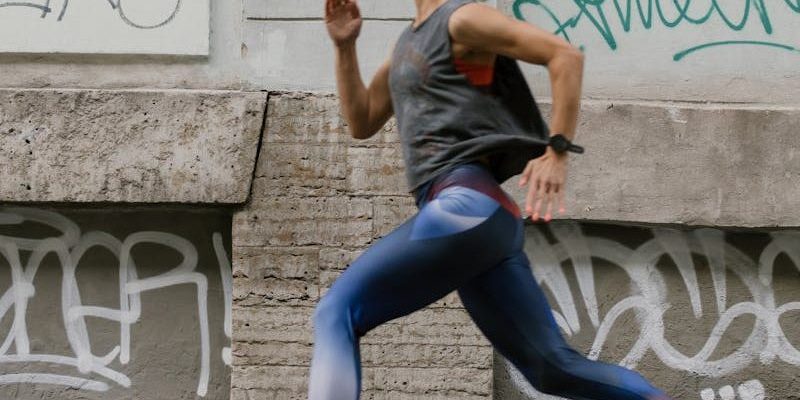As summer approaches, the appeal of running and jogging increases. Whether you’re a seasoned marathoner or a casual jogger, the risk of injuries such as Achilles tendonitis and plantar fasciitis looms large.
These common running injuries can significantly hinder your progress and enjoyment of the sport. However, with the right approach, you can prevent and recover from these issues. A calf wedge or slant board for calf stretching is a go-to tool for the seasoned runner, providing targeted exercises that can be seamlessly integrated into your warm-up and cool-down routines.
Let’s explore three popular techniques to help runners and joggers prevent injuries and recover effectively.
 on Amazon.com recommended by Physical Therapists.
Achilles tendonitis and plantar fasciitis are common but preventable running injuries. By incorporating a slant board for calf stretching into your routine, you can enhance your warm-up, strengthen your tendons, and improve your post-run recovery. Embrace these techniques to keep your running journey smooth, injury-free, and enjoyable throughout the summer and beyond.
For more tips and tools to enhance your athletic performance and prevent injuries, visit BAMathleticaKarma.com. Happy running!
on Amazon.com recommended by Physical Therapists.
Achilles tendonitis and plantar fasciitis are common but preventable running injuries. By incorporating a slant board for calf stretching into your routine, you can enhance your warm-up, strengthen your tendons, and improve your post-run recovery. Embrace these techniques to keep your running journey smooth, injury-free, and enjoyable throughout the summer and beyond.
For more tips and tools to enhance your athletic performance and prevent injuries, visit BAMathleticaKarma.com. Happy running!
Understanding Achilles Tendonitis and Plantar Fasciitis
Before diving into prevention and recovery techniques, it’s crucial to understand these injuries. Achilles tendonitis involves inflammation of the Achilles tendon, which connects the calf muscles to the heel bone. It often results from overuse or sudden increases in running intensity. Plantar fasciitis, on the other hand, involves inflammation of the plantar fascia, a thick band of tissue running across the bottom of the foot. This condition typically causes heel pain and can be exacerbated by repetitive stress and improper foot mechanics.Technique 1: Dynamic Calf Stretching with a Slant Board
Dynamic stretching is a crucial component of a runner’s warm-up routine. Incorporating a slant board for calf stretching can enhance the effectiveness of these stretches by providing a controlled and gradual increase in stretch intensity. How to Perform Dynamic Calf Stretching with a Slant Board:-
- Positioning: Stand on the slant board with your feet shoulder-width apart. Ensure the board is set at a comfortable angle that allows you to feel a gentle stretch in your calves.
- Movement: Slowly rock forward and backward, shifting your weight from your heels to the balls of your feet. This dynamic motion helps to warm up the calf muscles and Achilles tendon gradually.
- Repetitions: Perform this movement for 1-2 minutes before your run, ensuring you maintain a fluid and controlled motion.
Technique 2: Eccentric Calf Raises on a Slant Board
Eccentric exercises are highly effective for both preventing and rehabilitating Achilles tendonitis. These exercises focus on the lengthening phase of muscle contraction, which can help strengthen the Achilles tendon and reduce pain. How to Perform Eccentric Calf Raises on a Slant Board:-
- Positioning: Stand on the slant board with only the balls of your feet on the edge, allowing your heels to hang off. Use a wall or sturdy surface for balance if needed.
- Movement: Raise your heels as high as possible, then slowly lower them back down below the level of the slant board. This lowering phase should be slow and controlled, taking about 3-5 seconds.
- Repetitions: Aim for 3 sets of 15 repetitions, performed twice daily.
Technique 3: Static Calf Stretching Post-Run
Static stretching post-run helps to elongate the muscles and improve flexibility, which is crucial for preventing plantar fasciitis. Using a slant board for calf stretching post-run can ensure you achieve an optimal stretch. How to Perform Static Calf Stretching with a Slant Board:-
- Positioning: Place the slant board at a moderate incline and stand on it with both feet. Keep your legs straight and heels down to maximize the stretch in your calves.
- Stretch: Hold this position for 30 seconds to 1 minute, focusing on a deep, relaxing stretch. Ensure you feel the stretch along the entire calf muscle and not just in your feet or lower legs.
- Repetitions: Repeat this stretch 2-3 times, alternating with brief periods of rest.







